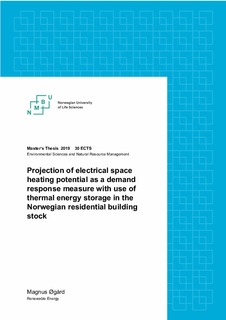| dc.contributor.advisor | Kirkerud, Jon Gustav | |
| dc.contributor.advisor | Sandberg, Nina Holck | |
| dc.contributor.author | Øgård, Magnus | |
| dc.coverage.spatial | Norway | nb_NO |
| dc.date.accessioned | 2019-07-23T12:26:31Z | |
| dc.date.available | 2019-07-23T12:26:31Z | |
| dc.date.issued | 2019 | |
| dc.identifier.uri | http://hdl.handle.net/11250/2606309 | |
| dc.description.abstract | The aim and goal of this thesis is to analyze and investigate the maximum potential of load shifting and delivered energy in the total Norwegian residential building stock quantified to different segments, building age classes and refurbishment states including usage of thermal energy storage in a demand response measure in the context of electrical space heating in Norwegian residential buildings quantified to the same segments in the stock in the period 1960-2100. The thesis will also analyze and investigate how and why a Norwegian wide-based demand response scheduling program may be integrated into the Norwegian power market in the future. Norway which is situated in a cold-temperate climate, use a significant share of electricity as the source for space heating. The thesis uses a building stock model developed by Nina Holck Sandberg at NTNU. Data gathered from a building stock energy model also developed by Sandberg is used to analyze and investigate the potential of electrical space heating and thermal mass. Segmentation of a building stock model into segments and cohorts gives detail insight into changing stock composition. The thesis uses a social science approach, therefore use of engineering modeling are excluded from the thesis. The estimated “real” delivered electricity as space heating in the total Norwegian residential building stock is found to be 17.9 TWh in 2019 and 11.4 TWh in 2050, while the maximum estimated load shifting potential is found to be 3.7 GW in 2019 and 2.3 GW in 2050. Effective thermal capacity is calculated in a bottom-up accounting model with a theoretical assumptive-intuitive rule-ofthumb approach quantifying interior partitions with a variation of different materials, which possess dissimilar thermal attributes including adjacent ratios of window to wall, internal wall and wall to floor. The total available effective heat capacity in the total Norwegian residential building stock is found be 11.9 GWh/K in 2020 and 16.1 GWh/K in 2050. | nb_NO |
| dc.description.abstract | Formålet med denne studien er å analysere og undersøke maksimalt potensial av flytt av last i tid og levert energi i den totale norske bolig-bygningsmassen delt inn i ulike segmenter, konstruksjons-årsklasser og renoveringstilstander, inkludert bruk av termisk energilagring i et forbrukerfleksibilitetstiltak i konteksten av elektrisk romoppvarming i norske boliger delt inn i de samme segmentene i bygningsmassen i perioden 1960-2100. Avhandlingen vil også analysere og undersøke hvordan og hvorfor et storstilt norsk forbrukerfleksibilitetsprogram kan bli integrert i det norske kraftmarkedet i fremtiden. Norge som er lokalisert i et kaldt temperert klima, bruker en betydelig andel elektrisitet som kilde til romoppvarming. Avhandlingen bruker en bolig-bygningsmassemodell utviklet av Nina Holck Sandberg ved NTNU. Data som er samlet inn fra en bolig-bygningsmasse energimodell, også utviklet av Sandberg, brukes til å analysere og undersøke potensialet for elektrisk romoppvarming og termisk masse. Segmentering av en bygningsmassemodell i segmenter og kohorter gir detaljert innsikt i endring av bestandssammensetningen. Avhandlingen bruker en samfunnsvitenskapelig tilnærming, så bruk av ingeniørmodellering er utelukket fra avhandlingen. Den anslåtte «virkelige» leverte elektrisiteten som romoppvarming i den totale norske boligbygningsmassen er funnet å være 17,9 TWh i 2019 og 11,4 TWh i 2050, mens maksimal potensial av flytt av last i tid er funnet å være 3,7 GW i 2019 og 2,3 GW i 2050. Effektiv termisk kapasitet beregnes i en «bottom-up» modell med en teoretisk intuitiv «rule-of-thumb» metode som kvantifiserer innvendige bygningsdeler med en variasjon av forskjellige attributter, inkludert forhold mellom vindu og vegg, indre vegg og vegg til gulv lagt til grunn. Den totale tilgjengelige effektive varmekapasiteten i den totale norske bolig-bygningsmassen er funnet å være 11,9 GWh/K i 2020 og 16,1 GWh/K i 2050. | nb_NO |
| dc.language.iso | eng | nb_NO |
| dc.publisher | Norwegian University of Life Sciences, Ås | nb_NO |
| dc.rights | Navngivelse 4.0 Internasjonal | * |
| dc.rights.uri | http://creativecommons.org/licenses/by/4.0/deed.no | * |
| dc.subject | Renewable energy | nb_NO |
| dc.subject | Fornybar energi | nb_NO |
| dc.title | Projection of electrical space heating potential as a demand response measure with use of thermal energy storage in the Norwegian residential building stock | nb_NO |
| dc.type | Master thesis | nb_NO |
| dc.description.version | submittedVersion | nb_NO |
| dc.source.pagenumber | 99 | nb_NO |
| dc.description.localcode | M-FORNY | nb_NO |

